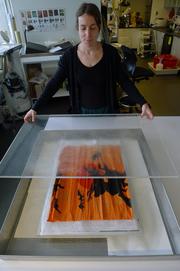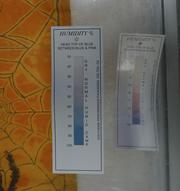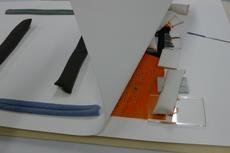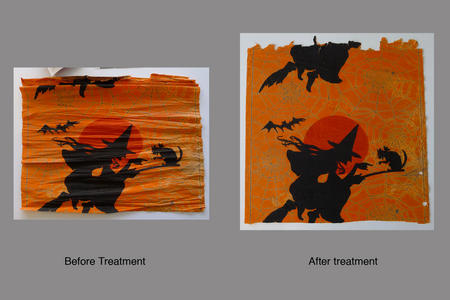This post was co-written by Nora Lockshin, Conservator, and Mary Markey, Archives Technician.
Mary: Nora, since we’ve worked together at the Archives for several years, you already know that I love Halloween. Come October 1st, I’m bringing out the pumpkins and witches and planning my annual party. I began collecting Halloween memorabilia as a child, at our local dime store—picking up paper decorations for the parties my mother threw for our Brownie Troop. I’ve added to those purchases over the years, finding the antique papier-mâché jack-o-lanterns, holiday postcards, and vintage photographs that document the history of Halloween in America.
Over the past thirty years, collecting Halloween memorabilia has become a pricey hobby. Decorated crepe paper from the 1920s is very much sought after, because of the beautiful graphics, and can be quite expensive. I wanted to have at least a sample for my collection—and found this little snippet on eBay for a few dollars. As you can see, it’s very crumpled—and crepe paper is moisture sensitive. Just storing it in a humid place will result in the fading and running that you can see at the lower left of this piece. Is there anything you can do to flatten the piece?

Nora: EEEK! What could be scarier than humidification and flattening of moisture-sensitive, highly textured, ninety-year-old rare ephemera? We have a couple things to consider here—first of all, the flexibility of the paper in its current rolled state is of immediate concern. Happily, it was rolled with an outer wrapping when it was sent, so it hasn’t actually expanded to the size of the mailing tube and we were able to get it out easily without tugging on the fragile paper, however, it remains severely creased and shrunken. Careful humidification in a humidity chamber will give the paper added flexibility and may help us to bring it back to its original proportions, which we can only estimate.

Before we consider humidification, we usually do solubility tests to check the stability of the dyes and inks, but as you mentioned, Mary, we can already see from some discolored spots from a prior “water event” that the orange dye in the crepe paper is water-sensitive, so we’ll need to be extra careful about controlling condensation in the humidification tank. Lastly, the crepe paper in its original state had and still has a significant crinkly texture to allow for expansion and decorative uses—that’s a characteristic we want to avoid changing, so we will pay careful attention to the texture of materials we lay against it, and to how much weight, pressure, and restraint we use while applying drying techniques.
 With these things in mind I started treatment on Mary’s Halloween crepe paper. After the object had been in the humidity chamber for a sufficient period, it was taken out and manipulated, stretching it back into shape, encouraging some expansion and unfolding the tattered edges. Although I had to remain wary of denting the sensitive surface and flattening the crepe texture, I still had to gently restrain the paper as I worked to ensure it would stay in place while I laid down a dry blotter and felts, which would slowly absorb and evaporate moisture in a controlled fashion (this process was repeated twice during the treatment process to remove excess moisture). What you can’t see in the picture is my wicked fast “magician’s tablecloth” technique where I quickly removed the weights as I lay down the absorbent surfaces, trying to beat the clock and avoid losing too much moisture as I worked.
With these things in mind I started treatment on Mary’s Halloween crepe paper. After the object had been in the humidity chamber for a sufficient period, it was taken out and manipulated, stretching it back into shape, encouraging some expansion and unfolding the tattered edges. Although I had to remain wary of denting the sensitive surface and flattening the crepe texture, I still had to gently restrain the paper as I worked to ensure it would stay in place while I laid down a dry blotter and felts, which would slowly absorb and evaporate moisture in a controlled fashion (this process was repeated twice during the treatment process to remove excess moisture). What you can’t see in the picture is my wicked fast “magician’s tablecloth” technique where I quickly removed the weights as I lay down the absorbent surfaces, trying to beat the clock and avoid losing too much moisture as I worked.
Finally, I do get to say “TAA-DAA!” like a magician, when I reveal the Halloween-themed crepe paper a couple of days later. You can see the dramatic difference from its eerily shrunken state to a banner suitable for the occasional seasonal display. While I wouldn’t fly it from your door anytime soon, due to its fragility, it is certainly suitable for storage and occasional display in a window mat with cover (a mat package with an additional protective cover board that wraps over the window mat), a document wrap, or framing with UV protective glazing. Happy Halloween!

Produced by the Smithsonian Institution Archives. For copyright questions, please see the Terms of Use.

Leave a Comment